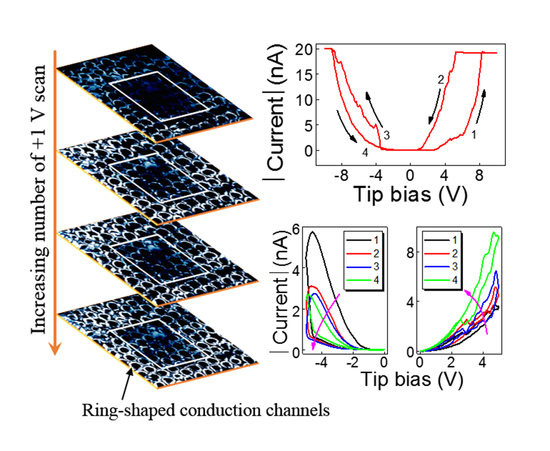Nanoscale Ring-Shaped Conduction Channels with Memristive Behavior in BiFeO3 Nanodots
Abstract
1. Introduction
2. Materials and Methods
2.1. Materials Preparation
2.2. Characterization
3. Results and Discussion
4. Conclusions
Supplementary Materials
Author Contributions
Funding
Conflicts of Interest
References
- Lévy, L.P.; Dolan, G.; Dunsmuir, J.; Bouchiat, H. Magnetization of mesoscopic copper rings: Evidence for persistent currents. Phys. Rev. Lett. 1990, 64, 2074–2077. [Google Scholar] [CrossRef] [PubMed]
- Lévy, L.P. Persistent currents in mesoscopic copper rings. Physica B 1991, 169, 245–256. [Google Scholar] [CrossRef]
- Han, X.; Wei, H.; Peng, Z.; Yang, H.; Feng, J.; Du, G.; Sun, Z.; Jiang, L.; Ma, M.; Wang, Y.; et al. A novel design and fabrication of magnetic random access memory based on nano-ring-type magnetic tunnel junctions. J. Mater. Sci. Technol. 2007, 23, 304–306. [Google Scholar]
- Han, X.; Wen, Z.; Wei, H. Nanoring magnetic tunnel junction and its application in magnetic random access memory demo devices with spin-polarized current switching (invited). J. Appl. Phys. 2008, 103, 07E933. [Google Scholar] [CrossRef]
- Hu, X.L.; Yu, J.C.; Gong, J.M.; Li, Q.; Li, G.S. α-Fe2O3 nanorings prepared by a microwave-assisted hydrothermal process and their sensing properties. Adv. Mater. 2007, 19, 2324–2329. [Google Scholar] [CrossRef]
- Gou, X.; Wang, G.; Yang, J.; Park, J.; Wexler, D. Chemical synthesis, characterisation and gas sensing performance of copper oxide nanoribbons. J. Mater. Chem. 2008, 18, 965–969. [Google Scholar] [CrossRef]
- Jo, S.H.; Chang, T.; Ebong, I.; Bhadviya, B.B.; Mazumder, P.; Lu, W. Nanoscale memristor device as synapse in neuromorphic systems. Nano Lett. 2010, 10, 1297–1301. [Google Scholar] [CrossRef]
- Indiveri, G.; Linares-Barranco, B.; Legenstein, R.; Deligeorgis, G.; Prodromakis, T. Integration of nanoscale memristor synapses in neuromorphic computing architectures. Nanotechnology 2013, 24, 384010. [Google Scholar] [CrossRef]
- Wang, Z.; Joshi, S.; Savel’ev, S.E.; Jiang, H.; Midya, R.; Lin, P.; Hu, M.; Ge, N.; Strachan, J.P.; Li, Z.; et al. Memristors with diffusive dynamics as synaptic emulators for neuromorphic computing. Nat. Mater. 2017, 16, 101–108. [Google Scholar] [CrossRef]
- Kim, D.J.; Lu, H.; Ryu, S.; Bark, C.-W.; Eom, C.-B.; Tsymbal, E.Y.; Gruverman, A. Ferroelectric tunnel memristor. Nano Lett. 2012, 12, 5697–5702. [Google Scholar] [CrossRef]
- Chanthbouala, A.; Garcia, V.; Cherifi, R.O.; Bouzehouane, K.; Fusil, S.; Moya, X.; Xavier, S.; Yamada, H.; Deranlot, C.; Mathur, N.D.; et al. A ferroelectric memristor. Nat. Mater. 2012, 11, 860–864. [Google Scholar] [CrossRef] [PubMed]
- Celano, U. Metrology and Physical Mechanisms in New Generation Ionic Devices. Ph.D. Thesis, The KU Leuven and IMEC, Leuven, Belgium, 2015. [Google Scholar]
- Waser, R.; Dittmann, R.; Staikov, G.; Szot, K. Redox-based resistive switching memories—Nanoionic mechanisms, prospects, and challenges. Adv. Mater. 2009, 21, 2632–2663. [Google Scholar] [CrossRef]
- Fan, Z.; Fan, H.; Yang, L.; Li, P.; Lu, Z.; Tian, G.; Huang, Z.; Li, Z.; Yao, J.; Luo, Q.; et al. Resistive switching induced by charge trapping/detrapping: A unified mechanism for colossal electroresistance in certain Nb: SrTiO3-based heterojunctions. J. Mater. Chem. C 2017, 5, 7317–7327. [Google Scholar] [CrossRef]
- Wang, J.; Neaton, J.B.; Zheng, H.; Nagarajan, V.; Ogale, S.B.; Liu, B.; Viehland, D.; Vaithyanathan, V.; Schlom, D.G.; Waghmare, U.V.; et al. Epitaxial BiFeO3 multiferroic thin film heterostructures. Science 2003, 299, 1719–1722. [Google Scholar] [CrossRef] [PubMed]
- Neaton, J.B.; Ederer, C.; Waghmare, U.V.; Spaldin, N.A.; Rabe, K.M. First-principles study of spontaneous polarization in multiferroic BiFeO3. Phys. Rev. B 2005, 71, 014113. [Google Scholar] [CrossRef]
- Li, Y.W.; Sun, J.L.; Chen, J.; Meng, X.J.; Chu, J.H. Structural ferroelectric dielectric and magnetic properties of BiFeO3/Pb(Zr0.5,Ti0.5)O3 multilayer films derived by chemical solution deposition. Appl. Phys. Lett. 2005, 87, 182902. [Google Scholar] [CrossRef]
- Qi, X.; Dho, J.; Blamire, M.; Jia, Q.; Lee, J.-S.; Foltyn, S.; MacManus-Driscoll, J.L. Epitaxial growth of BiFeO3 thin films by LPE and sol-gel method. J. Magn. Magn. Mater. 2004, 283, 415–421. [Google Scholar] [CrossRef]
- Kubel, F.; Schmid, H. Structure of a ferroelectric and ferroelastic monodomain crystal of the perovskite BiFeO3. Acta Cryst. B 1990, 46, 698–702. [Google Scholar] [CrossRef]
- Zhang, J.X.; Xiang, B.; He, Q.; Seidel, J.; Zeches, R.J.; Yu, P.; Yang, S.Y.; Wang, C.H.; Chu, Y.H.; Martin, L.W.; et al. Large field-induced strains in a lead-free piezoelectric material. Nat. Nanotechnol. 2011, 6, 98–102. [Google Scholar] [CrossRef]
- Kim, K.E.; Jang, B.K.; Heo, Y.; Lee, J.H.; Jeong, M.; Lee, J.Y.; Seidel, J.; Yang, C.H. Electric control of straight stripe conductive mixed-phase nanostructures in La-doped BiFeO3. NPG Asia. Mater. 2014, 6, e81. [Google Scholar] [CrossRef]
- Zavaliche, F.; Das, R.R.; Kim, D.M.; Eom, C.B.; Yang, S.Y.; Shafer, P.; Ramesh, R. Ferroelectric domain structure in epitaxial BiFeO3 films. Appl. Phys. Lett. 2005, 87, 182912. [Google Scholar] [CrossRef]
- Zavaliche, F.; Shafer, P.; Ramesh, R.; Cruz, M.P.; Das, R.R.; Kim, D.M.; Eom, C.B. Polarization switching in epitaxial BiFeO3 films. Appl. Phys. Lett. 2005, 87, 252902. [Google Scholar] [CrossRef]
- Chu, Y.H.; Zhan, Q.; Martin, L.W.; Cruz, M.P.; Yang, P.L.; Pabst, G.W.; Zavaliche, F.; Yang, S.Y.; Zhang, J.X.; Chen, L.Q.; et al. Nanoscale domain control in multiferroic BiFeO3 thin films. Adv. Mater. 2006, 18, 2307–2311. [Google Scholar] [CrossRef]
- Seidel, J.; Martin, L.W.; He, Q.; Zhan, Q.; Chu, Y.H.; Rother, A.; Hawkridge, M.E.; Maksymovych, P.; Yu, P.; Gajek, M.; et al. Conduction at domain walls in oxide multiferroics. Nat. Mater. 2009, 8, 229–234. [Google Scholar] [CrossRef] [PubMed]
- Maksymovych, P.; Seidel, J.; Chu, Y.H.; Wu, P.; Baddorf, A.P.; Chen, L.-Q.; Kalinin, S.V.; Ramesh, R. Dynamic conductivity of ferroelectric domain walls in BiFeO3. Nano Lett. 2011, 11, 1906–1912. [Google Scholar] [CrossRef] [PubMed]
- Li, Z.; Wang, Y.; Tian, G.; Li, P.; Zhao, L.; Zhang, F.; Yao, J.; Fan, H.; Song, X.; Chen, D.; et al. High-density array of ferroelectric nanodots with robust and reversibly switchable topological domain states. Sci. Adv. 2017, 3, e1700919. [Google Scholar] [CrossRef] [PubMed]
- Zhang, S.L.; Xue, F.; Wu, R.; Cui, J.; Jiang, Z.M.; Yang, X.J. Conductive atomic force microscopy studies on the transformation of GeSi quantum dots to quantum rings. Nanotechnology 2009, 20, 135703. [Google Scholar] [CrossRef] [PubMed]
- Wang, C.; Ke, S.Y.; Yang, J.; Hu, W.D.; Qiu, F.; Wang, R.F.; Yang, Y. Electronic properties of single Ge/Si quantum dot grown by ion beam sputtering deposition. Nanotechnology 2015, 26, 105201. [Google Scholar] [CrossRef] [PubMed]
- Ou, X.; Shuai, Y.; Luo, W.B.; Siles, P.F.; Koegler, R.; Fiedler, J.; Reuther, H.; Zhou, S.Q.; Huebner, R.; Facsko, S.; et al. Forming-free resistive switching in multiferroic BiFeO3 thin films with enhanced nanoscale shunts. ACS Appl. Mater. Interfaces 2013, 5, 12764–12771. [Google Scholar] [CrossRef] [PubMed]
- Kalinin, S.V.; Jesse, S.; Tselev, A.; Baddorf, A.P.; Balke, N. The role of electrochemical phenomena in scanning probe microscopy of ferroelectric thin films. ACS Nano 2011, 5, 5683–5691. [Google Scholar] [CrossRef] [PubMed]
- Farokhipoora, S.; Nohedab, B. Screening effects in ferroelectric resistive switching of BiFeO3 thin films. APL Mater. 2014, 2, 056102. [Google Scholar] [CrossRef]
- Tan, Z.W.; Tian, J.J.; Fan, Z.; Lu, Z.X.; Zhang, L.Y.; Zheng, D.F.; Wang, Y.D.; Chen, D.Y.; Qin, M.H.; Zeng, M.; et al. Polarization imprint effects on the photovoltaic effect in Pb(Zr,Ti)O3 thin films. Appl. Phys. Lett. 2018, 112, 152905. [Google Scholar] [CrossRef]
- Son, J.Y.; Bang, S.H.; Cho, J.H. Kelvin probe force microscopy study of and thin films for SrBi2Ta2O9 and PbZr0.53Ti0.47O3 high-density nonvolatile storage devices. Appl. Phys. Lett. 2003, 82, 3505–3507. [Google Scholar] [CrossRef]
- Kim, Y.; Bae, C.; Ryu, K.; Ko, H.; Kim, Y.K.; Hong, S.; Shin, H. Origin of surface potential change during ferroelectric switching in epitaxial thin films studied by scanning force microscopy. Appl. Phys. Lett. 2009, 94, 032907. [Google Scholar] [CrossRef]
- Muenstermann, R.; Menke, T.; Dittmann, R.; Mi, S.; Jia, C.-L.; Park, D.; Mayer, J. Correlation between growth kinetics and nanoscale resistive switching properties of SrTiO3 thin films. J. Appl. Phys. 2010, 108, 124504. [Google Scholar] [CrossRef]
- Celano, U.; Goux, L.; Degraeve, R.; Fantini, A.; Richard, O.; Bender, H.; Jurczak, M.; Vandervorst, W. Imaging the three-dimensional conductive channel in filamentary-based oxide resistive switching memory. Nano Lett. 2015, 15, 7970–7975. [Google Scholar] [CrossRef]
- Kalinin, S.V.; Bonnell, D.A. Imaging mechanism of piezoresponse force microscopy of ferroelectric surfaces. Phys. Rev. B 2001, 65, 125411. [Google Scholar] [CrossRef]
- Fan, Z.; Fan, H.; Lu, Z.; Li, P.; Huang, Z.; Tian, G.; Yang, L.; Yao, J.; Chen, C.; Chen, D.; et al. Ferroelectric diodes with charge injection and trapping. Phys. Rev. Appl. 2017, 7, 014020. [Google Scholar] [CrossRef]
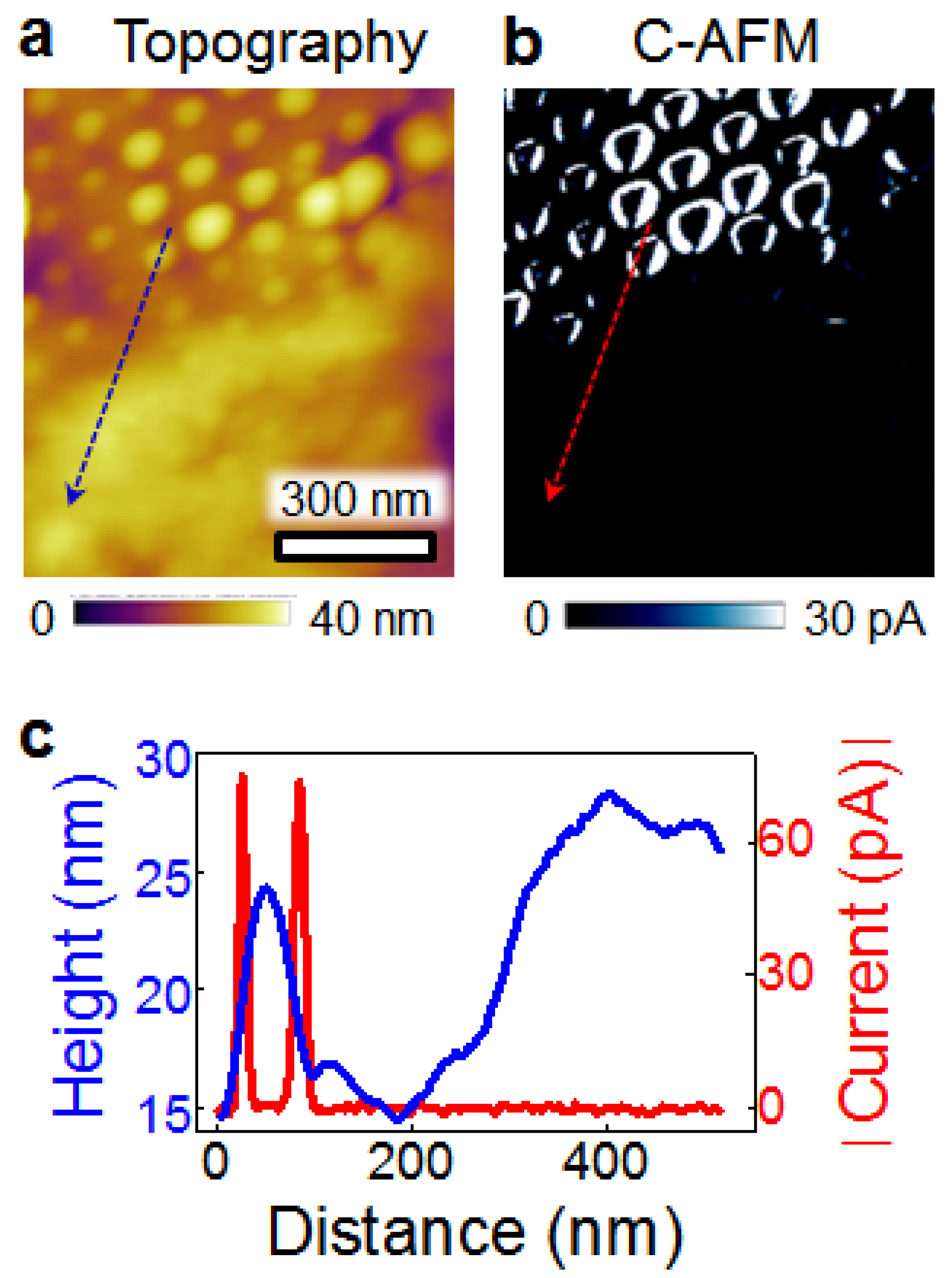

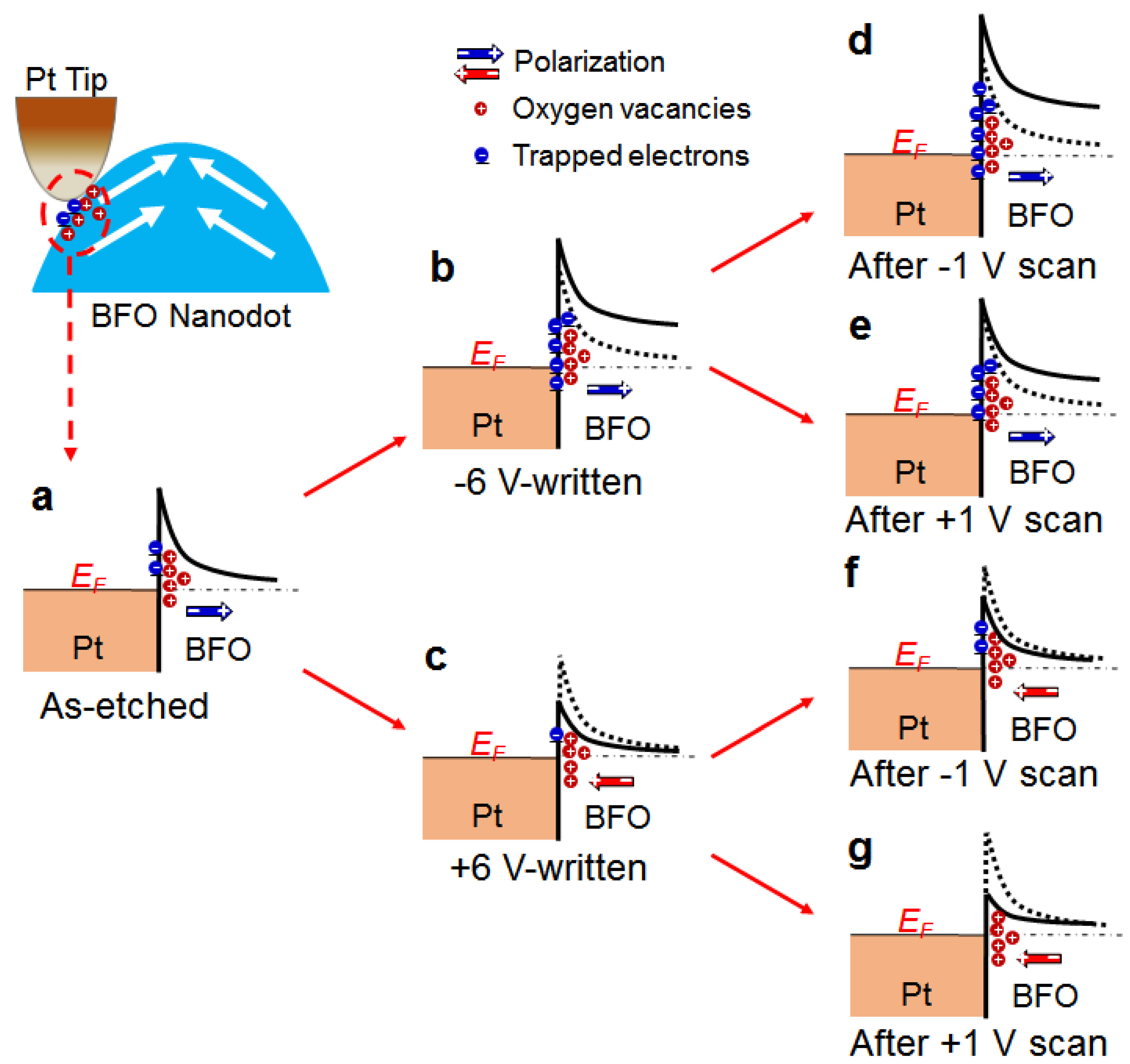
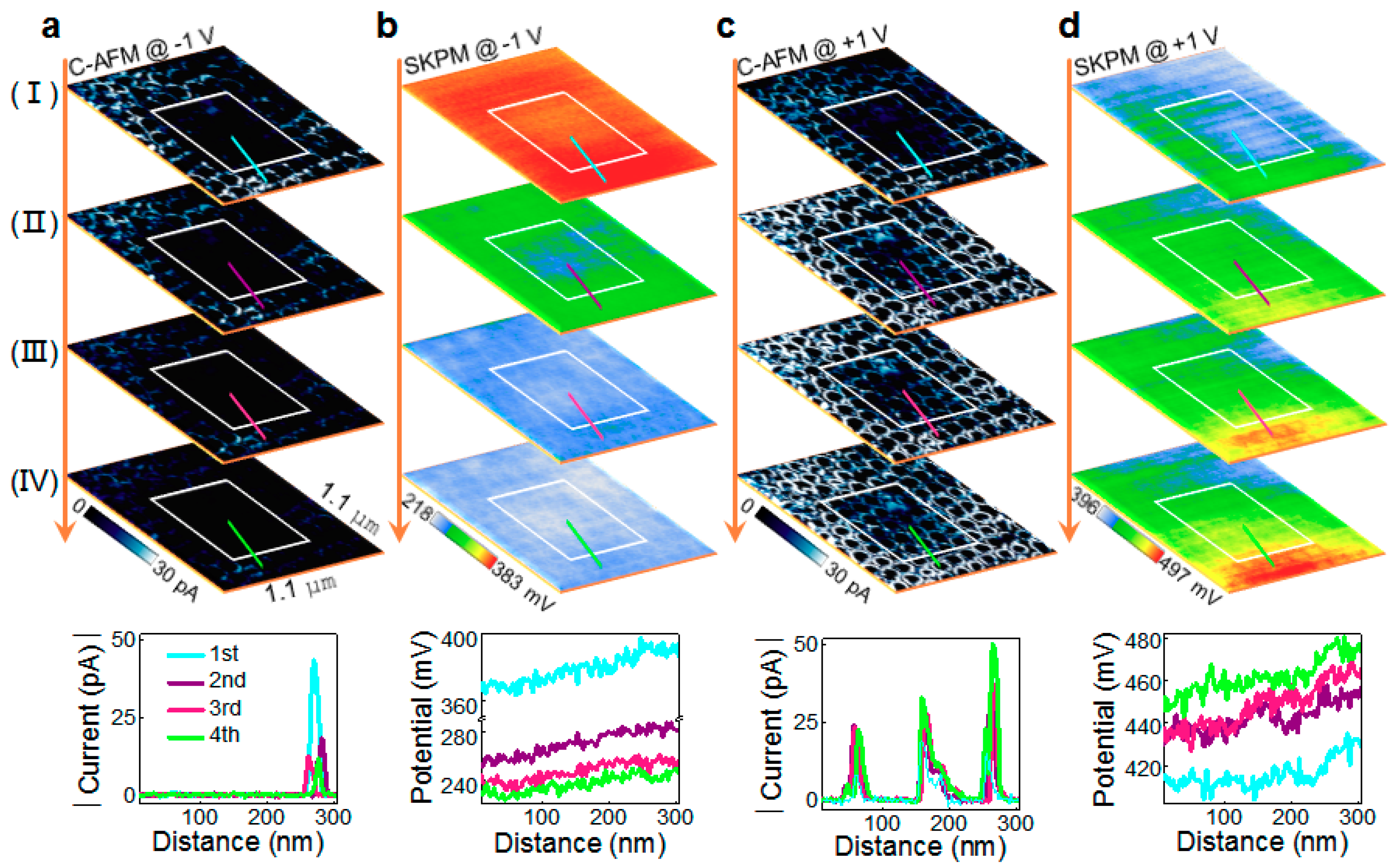
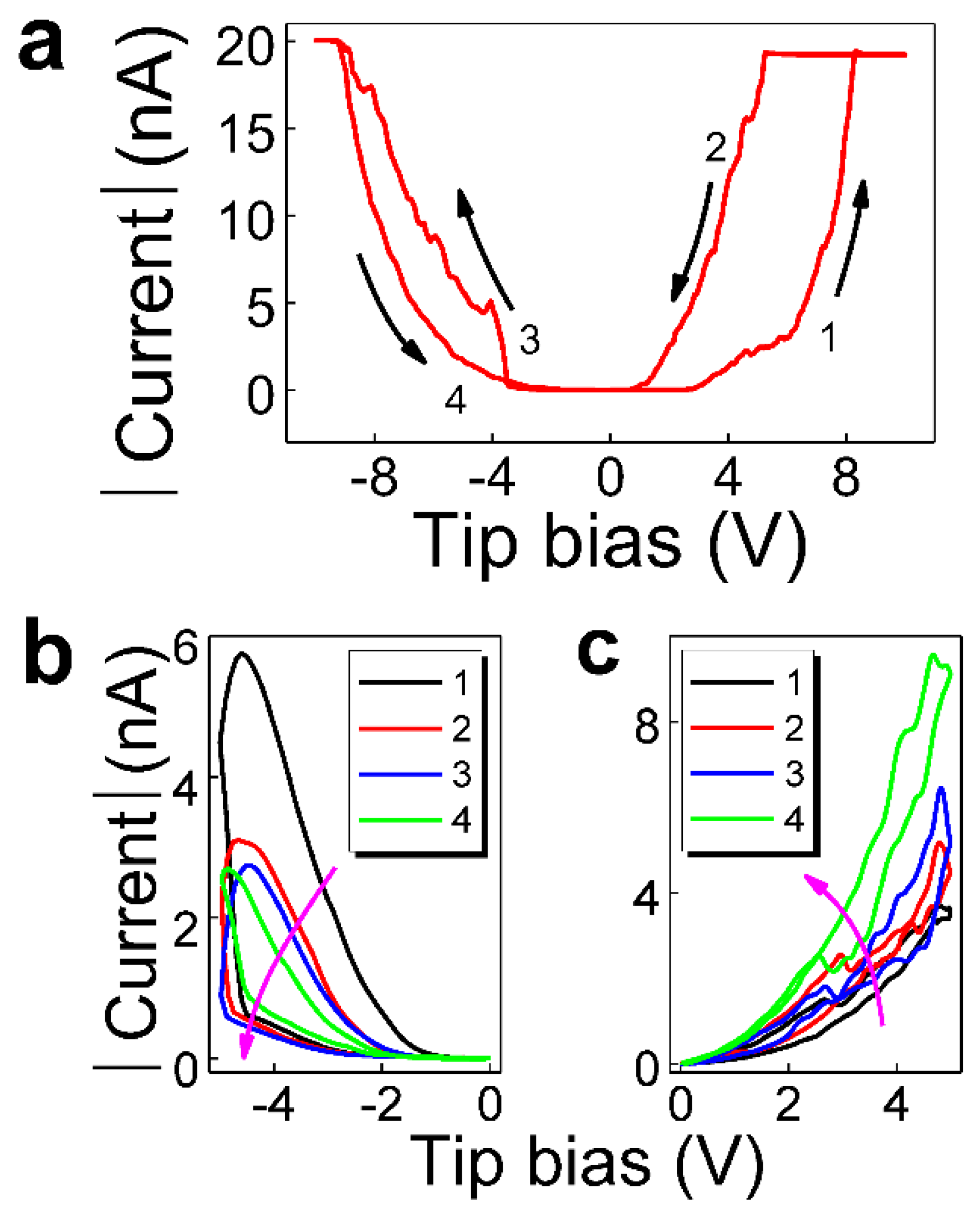
© 2018 by the authors. Licensee MDPI, Basel, Switzerland. This article is an open access article distributed under the terms and conditions of the Creative Commons Attribution (CC BY) license (http://creativecommons.org/licenses/by/4.0/).
Share and Cite
Li, Z.; Fan, Z.; Zhou, G. Nanoscale Ring-Shaped Conduction Channels with Memristive Behavior in BiFeO3 Nanodots. Nanomaterials 2018, 8, 1031. https://doi.org/10.3390/nano8121031
Li Z, Fan Z, Zhou G. Nanoscale Ring-Shaped Conduction Channels with Memristive Behavior in BiFeO3 Nanodots. Nanomaterials. 2018; 8(12):1031. https://doi.org/10.3390/nano8121031
Chicago/Turabian StyleLi, Zhongwen, Zhen Fan, and Guofu Zhou. 2018. "Nanoscale Ring-Shaped Conduction Channels with Memristive Behavior in BiFeO3 Nanodots" Nanomaterials 8, no. 12: 1031. https://doi.org/10.3390/nano8121031
APA StyleLi, Z., Fan, Z., & Zhou, G. (2018). Nanoscale Ring-Shaped Conduction Channels with Memristive Behavior in BiFeO3 Nanodots. Nanomaterials, 8(12), 1031. https://doi.org/10.3390/nano8121031




